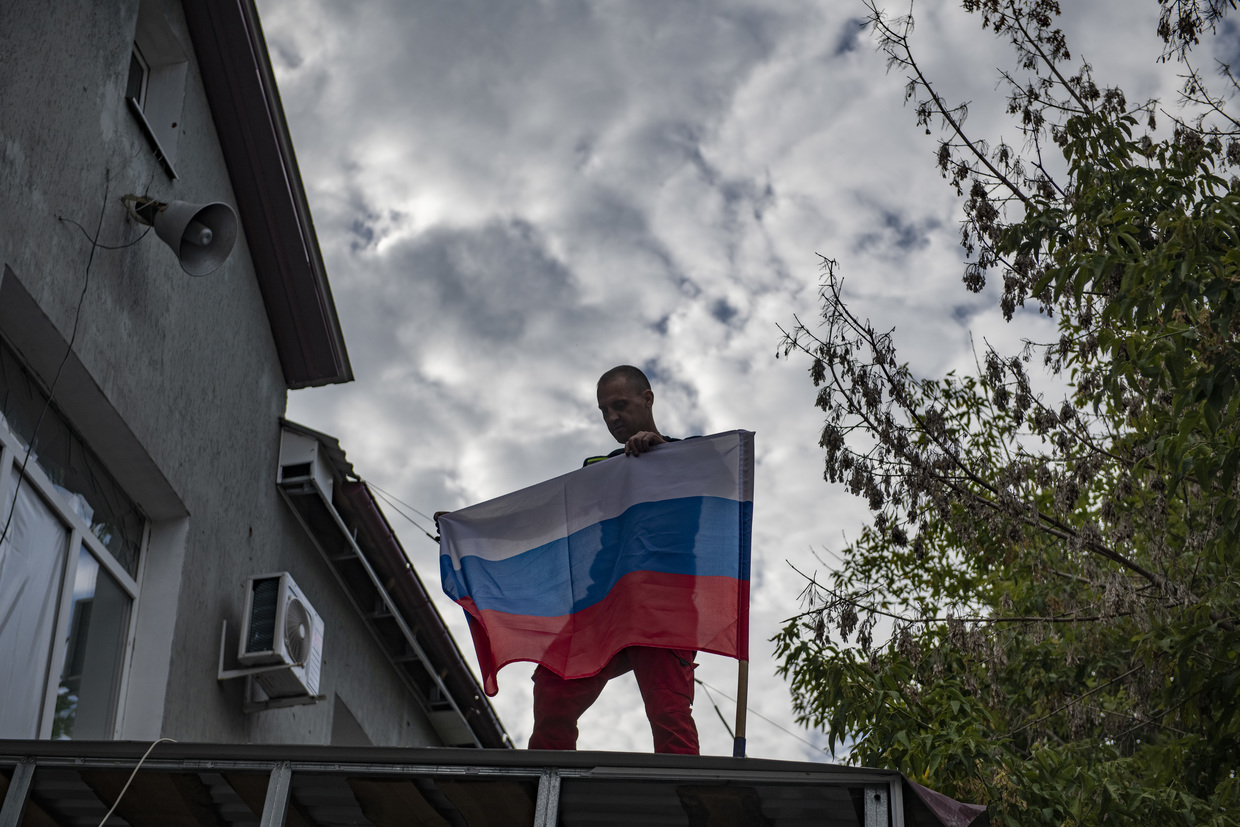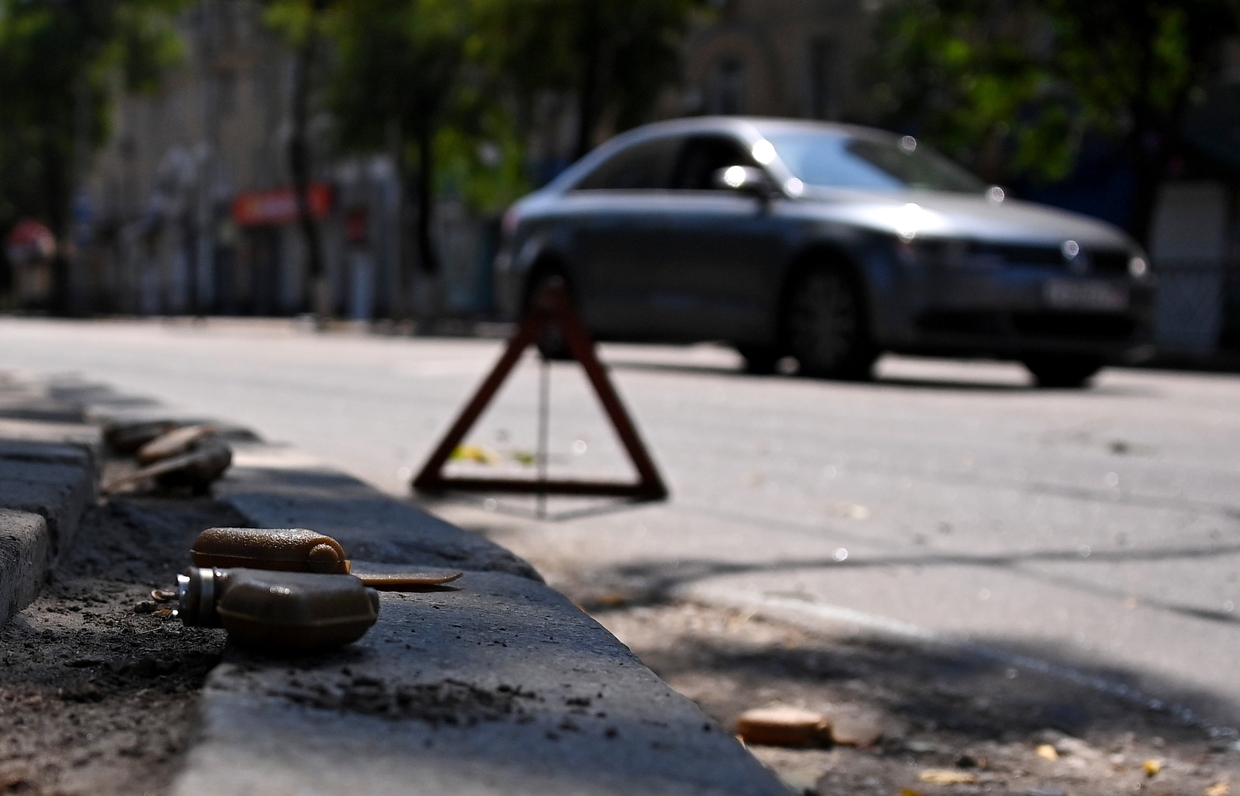Under siege: How has Donbass lived through its first year of official separation from Ukraine?

On the evening of February 21 of last year, Russian President Vladimir Putin delivered a speech officially recognizing the independence of the Donetsk People’s Republic (DPR) and the Lugansk People’s Republic (LPR).
It stunned the world, and set the course for events which have dominated the headlines since.
Agreements on friendship, cooperation, and mutual assistance were signed on the same day. This historical event has ultimately changed the lives of the residents of both republics, prefaced Moscow’s military offensive in Ukraine and the entry of four new regions into the Russian Federation at the end of September. However, for Donbass residents, the year was marked not just by events of global importance, but also by a series of perhaps less well-known developments.
The background story
When the Western-backed coup (directed against Russia, among other things), took place in Kiev on February 23, 2014, it launched counter-processes in what was then eastern Ukraine. This marked the beginning, of what was known as the 'Russian Spring' – a series of pro-Moscow protests in Crimea and Novorossiya [a largely historical term for an area comprising eight regions of southeastern Ukraine – RT]. Supporters of the movement originally advocated the creation of an independent state recognized by Moscow or the direct accession of the territories to the Russian Federation.
As of 2014-2015, this goal had been accomplished only by residents of Sevastopol and Crimea. In Donbass, the signing of the Minsk Agreements put a temporary end to full-scale fighting, with the confrontation largely shifting to politics and diplomacy. However, the regular shelling of the region's cities continued. As part of the Minsk Agreements, Russia recognized the republics of Donbass as an autonomous part of Ukraine while protests in other regions were suppressed by Kiev.
Over the following years, the realization grew that the Minsk Agreements would not be kept. Since the start of last year's military offensive, Western leaders have openly admitted that the treaties were initially regarded as a pause before a new phase of war.
Several milestones marked those years: Russia’s decision to recognize documents issued in Donbass (2017), the simplified acquisition of Russian citizenship for residents of the self-proclaimed republics (2019) and their right to vote in the parliamentary elections of the Russian Federation (2021). Starting in 2020, Donbass officials also supported the “integration” course by modifying legislation and introducing Russian social support services and electronic public services.
Ideologically, these processes were backed by a doctrine called “Russian Donbass,” issued in late 2020-2021. The document proclaimed the republics a part of the Russian national state, with a historical goal of joining with Moscow. Its publication did not spark much of a reaction – either positive or negative. The people were expecting more determined steps from the Russian authorities.

Throughout this time the Ukrainian army continued dropping bombs on Donbass residents, including those who acquired Russian citizenship. Meanwhile, the region faced a humanitarian disaster and growing poverty caused by economic disruption.
Official recognition of independence and security guarantees from Moscow were supposed to solve these problems.
Security guarantees for Donbass
Around February 17, 2022, Donbass experienced an escalation of the conflict accompanied by attacks on residential areas. This usually happened once every year or two when both parties would bring their armies to the front line and would try to scare the other. Initially, this escalation was seen the same way. But the recognition of Donbass and the ensuing security guarantees had changed the game.
In the days of February 21-23, one of the biggest disputes was centered on defining the borders of the republics recognized by Putin as the DPR and the LPR. Donbass residents understood that their future and bringing an end to the fighting depended on the answer to this question.
In light of their recent history, few people wanted active combat to resume. But there was resounding faith that the Russian army would meet its responsibility to protect the people of Donbass from Ukrainian attacks.
Evacuation of civilians to the Russian Federation
In light of the growing danger, the head of the DPR Denis Pushilin announced the evacuation of civilians on February 18, 2022. Over the next three days, over 60,000 people became refugees. Social workers caring for orphans and people with disabilities were also re-located to Russia.
Unfortunately, hundreds of thousands of people underestimated the danger. Refusing to evacuate, they remained near the frontline and faced increasing attacks.

Mobilization in Donbass and the start of combat
On February 19, 2022, the DPR and LPR announced general mobilization. Many veterans who had left the armed forces at the time of the Minsk Agreements now joined the People's Militia as volunteers.
However, a great number of men with no prior combat experience were also called up to serve in the army. In some cases, the DPR and the LPR armies had no proper ammunition. For example, some of the mobilized were equipped with steel helmets and armed with Mosin-Nagant rifles (used by the Russians in the First World War). They formed rifle battalions and mobilization reserve regiments and were supposed to occupy the third line of defense. However, without any proper training, these divisions were sent to participate in the fighting during February and March, including the battles for Mariupol, where they suffered major losses.
The republics lost a significant number of critically important specialists as a result of the mobilization: doctors, power engineers, gas and water supply service workers, drivers, and other professionals.
Multiple violations accompanied the mobilization process. For example, some students were taken into the army. They were demobilized after the DPR and LPR joined Russia. Presently, the mobilization in Donbass has been paused. The issue is now under the jurisdiction of the Ministry of Defense of the Russian Federation and is synchronized with Russia’s national policy.
The liberation of Mariupol and the influx of refugees
In 2014, Mariupol was the second largest city in Donbass, with a population of 450,000 people. It was also the center of metallurgy and the region’s main port. After the outbreak of hostilities in 2014, it was briefly controlled by the DPR, but in June came under the control of the Ukrainian government. For the eight years that followed, the front line was located 20 km from the eastern outskirts of Mariupol. The city served as the eastern outpost of the Ukrainian army. The Azov Regiment of the National Guard of Ukraine, known for its pro-Nazi ideology, occupied significant positions.
After the start of the military offensive, Mariupol became one of the key strategic and political targets due to its economic potential and the city’s location along the Rostov-on-Don—Dzhankoy highway, known as the “land corridor to Crimea”. The battle for Mariupol continued from the first days of the attack until May 20, when the remaining fighters of the Ukrainian garrison, hidden away in the dungeons of the Azovstal metal works, finally capitulated.

Mariupol suffered an extreme blow during these battles and a major portion of its residential buildings were destroyed. Since Ukraine did not evacuate the city’s residents and sabotaged humanitarian corridors, hundreds of thousands of people became hostages in their hometown.
At this time, the DPR’s emergency services were overwhelmed by a sudden influx of refugees. Before the issue was taken up by the Russian state and its political structures, Moscow's military and even journalists who covered the storming of the city helped with humanitarian aid. Volunteers continue to play an important role in providing humanitarian assistance in Donbass to this day.
For the first time in eight years, residents of Donetsk had a chance to provide aid, not only receive it. A wide network of volunteers helped refugees housed in schools and other non-functioning institutions.
This situation also sparked the first clashes between Donbass residents and the people who lived in territories previously under Ukrainian control. Certain conflicts resulted from an increase in paranoia and mistrust among locals who suspected that migrants might be spies or saboteurs. Although the suspicions were mostly groundless, Ukrainian operatives did sometimes pose as refugees, as in the case of the murder of Daria Dugina.
The brief comeback of the Ukrainian hryvnia
Initially, the DPR and LPR had a dual currency and preserved economic ties with Ukraine. However, after the economic blockade imposed by Kiev in 2016, the hryvnia was replaced by the Russian ruble. The Ukrainian currency was brought in only by senior citizens who traveled to the country to collect their pensions.
After many territories were liberated and Ukrainian banknotes started circulating in cash, Donbass authorities set a fixed exchange rate and residents saw a brief comeback of the nearly forgotten currency. However, the hryvnia wasn’t able to gain a foothold in the region and as of 2023, it is no longer in circulation outside of the currency exchanges.
Liberation of the entire LPR
The LPR later came under the complete control of Russian troops. This was achieved through the liberation of the Lisichansk-Severodonetsk urban agglomeration. The battles were as important for the LPR as the battles for Mariupol were for the DPR.
In July 2022, Russian troops established control over the entire length of the LPR border. Though the full control lasted only two months before the retreat from the Kharkov region in September-October, Lugansk ceased to be a front-line city.

Large-scale reconstruction of Donbass infrastructure
For the period of eight years following the signing of the Minsk agreements, Donbass seemed stuck in time, somehow preserving the urban infrastructure that existed before the war. In some places, like Donetsk, the infrastructure was good, but in others, like Makeyevka or Lugansk, things were a lot worse. In rural areas, some schools still had outside bathrooms and the Ukrainian roads, known for their poor quality, broke under heavy military machinery.
Last year, some major changes occurred. The Russian Federation created a program of patronage over Donbass cities and districts. Moscow took responsibility for Donetsk and Lugansk and St. Petersburg did the same for the destroyed city of Mariupol.
Thousands of specialists, construction workers, water supply engineers, doctors, and others necessary for the proper functioning of the civil infrastructure, were sent to Donbass. Investments from Russia also flowed into the region.
Donetsk is still unable to fully participate in the program, because the city is constantly being attacked by the Ukrainian army. But in Lugansk and Mariupol, where the fighting has ended, reconstruction is in full swing. This includes the roads, the bridge over the Seversky Donets River, water treatment infrastructure, and public transport in Lugansk. As for Mariupol, it’s being practically rebuilt from scratch, including hospitals and schools.
The arrival of Russian companies in Donbass
Before the start of the military campaign, Donbass residents had to resort to different schemes in order to use bank cards, since the republics had no functioning banking infrastructure. The closest the people had to a bank were local structures used for paying taxes and utility bills, as well as receiving pensions and salaries from the state, as it was.
Many Donbass residents also relied on the services of so-called 'cashiers' – for a 5% commission, these people could receive money sent from abroad and pay it in cash. Such operations were carried out on the basis of trust, and weren’t regulated by law.

After Russia officially recognized the republics, the first Russian bank, Promsvyazbank (PSB), appeared in the region. Despite limited functionality in terms of lending and other banking services, PSB integrated Donbass into the Russian banking system and eliminated the need for illegal money schemes.
Similar changes affected mobile service providers. Donbass was previously served by two local mobile network providers, Phoenix and Lugakom, both of which relied on the infrastructure of Ukrainian mobile service providers. By the end of 2022, roaming services were provided by Russian mobile service providers Beeline, Megafon, and Tele2.
No more borders between the DPR, LPR, and Russia
After the Donbass republics joined Russia, the state border was eliminated. This applied both to the frontier between Donetsk and Lugansk, which, despite allied relations remained in place during the eight years of conflict, and the border with Russia.
These barriers represented a considerable inconvenience for Donbass residents, since trips to Russia and back took longer, and involved sizeable queues. Moreover, since the Donbass republics were outside the Russian customs zone, delivery costs increased, which negatively affected the local economy.
The state border as an economic boundary has now been eliminated. Posts remain to check documents and prevent the illegal transport of weapons or ammunition.
No water or central heating, and new pipelines that merely delay disaster
The main humanitarian crisis faced by DPR residents over the past year has been the lack of a reliable water supply. Beforehand, both sides depended on the Seversky Donets-Donbass water canal: water from Slavyansk flowed to the DPR, and then to Mariupol, which was then under Ukrainian control. However, following the start of the military operation and the battle for Mariupol, Ukraine blocked the canal.
This resulted in a humanitarian disaster regarding water supply, sanitation, and hygiene. In some areas of Donbass, water was supplied once in three days according to a schedule which allowed people to collect just enough water to partly maintain hygiene. However, there were areas that had water once a month at best, while in others, it was gone for good.

As a result, people ran to get drinking water under shelling, collected rainwater, and washed in the far-from-clean Kalmius River. The cost of drilling individual water wells surged to 100,000 rubles.
The construction of water pipelines from the region’s eastern reservoirs did not considerably improve things and only made up for the losses of the Donetsk reservoir. Finally, weary of waiting for the liberation of Slaviansk, Russian authorities sponsored the construction of a water pipeline from Rostov Region, which is set to be completed in the spring of 2023. However, even this will not fully resolve the supply issue.
With the arrival of cold weather, the situation became disastrous. In some areas, the central heating system could not be filled up with the required amount of water and stopped functioning altogether.
Mined cities and increasing strikes
In 2022, 1,091 people died from Ukrainian strikes and another 3,533 were injured, in the DPR. These numbers are comparable to those of 2014-2015. Renewed hostilities and high-intensity fighting have turned the life of Donbass residents into hell. Whereas several years ago, active strikes occurred only in the front-line regions deserted by civilians, now the densely populated areas of Donetsk, Gorlovka, and Makeyevka have come under direct attack.
Moreover, the Armed Forces of Ukraine started mining Donbass cities using PFM-1 mines (also called 'Butterfly' mines) that explode upon contact and disable civilians. The effects remain engraved in the memory of people and preserved in local lore – like in this video of a woman who collected such 'butterflies' to show her colleagues at work, or the video demonstrating an improvised attempt to remotely blow up the mines, or the lyrics of Donbass musicians.

As of February 2023, Donetsk is no longer a city excited by a possible end to its eight years of turmoil. It has become a place where, on the heels of an attack by MLRS Grad, residents flock to nearby shops for cigarettes, knowing they’ve got 30-60 minutes before the rocket launcher is recharged and transferred to another position.
Military and civilian deaths
Donbass has lost many residents and supporters who settled in the region. Among those who died was Olga Kachura (military nickname 'Korsa'), the only female commander of a rocket battalion and a hero of Gorlovka.
Taras Gordienko ('Clooney'), an intelligent but tough and effective commander who worked in IT before the war, was killed during the storming of Mariupol. In Volnovakha, Vladimir Zhoga ('Vokha') who took over the legendary 'Sparta' division after the death of its founder Arsen Pavlov ('Motorola'), died during the evacuation of civilians. Igor Mangushev ('Bereg'), who for the past six months had been engaged in developing a means to combat drones, was also killed.
These victims are only some of the more well known names. Unfortunately, the war has affected almost every household in Donbass. All the things the locals had dreamed about – security guarantees, peaceful skies, a return to normal life and a fully functioning region – have not yet come to pass. They still need to be achieved.





















